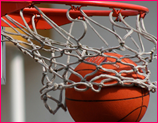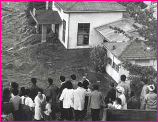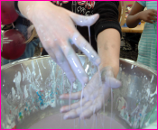Posted on July 31st, 2011 by Mary Lord
 In this lesson, students in grades 3 – 12 will explore the engineering design process by building a device that can launch a ping-pong ball high enough for them to catch it.
In this lesson, students in grades 3 – 12 will explore the engineering design process by building a device that can launch a ping-pong ball high enough for them to catch it.
Read More
Filed under: Class Activities, Grades 6-8, Grades 6-8, Grades 9-12, Grades 9-12, Grades K-5, Grades K-5, Lesson Plans | 1 Comment »
Tags: baseball, Design Squad, Energy, Engineering Design, force, levers, motion, NGSS aligned, Physics, simple machines
Posted on June 22nd, 2011 by Mary Lord
 These references and resources were initially developed for presentations at the Central PA STEM Conference and the 2011 ASEE K12 Workshop, which included a presentation focused on the green-roof lesson on the eGFI website.
These references and resources were initially developed for presentations at the Central PA STEM Conference and the 2011 ASEE K12 Workshop, which included a presentation focused on the green-roof lesson on the eGFI website.
Read More
Filed under: Class Activities, Grades 6-8, Grades 6-8, Grades 9-12, Grades 9-12, Grades K-5, Grades K-5, Lesson Plans, Web Resources | Comments Off on Green Roof Resources
Tags: Class Activities, Curriculum, Environmental Engineering, Environmental science, Grades 6-8, Grades 9-12, Grades K-5, green roof, Lesson Plan, Lesson Plans, Science
Posted on June 21st, 2011 by sah
 Summary: What is a green roof? How do rooftop gardens help protect the environment? In this field-observation activity, elementary students individually or working in teams will learn about green-roof design, energy conservation, and the types of plants and creatures that can live in the extreme environmental conditions found on rooftops.
Summary: What is a green roof? How do rooftop gardens help protect the environment? In this field-observation activity, elementary students individually or working in teams will learn about green-roof design, energy conservation, and the types of plants and creatures that can live in the extreme environmental conditions found on rooftops.
Read More
Filed under: Class Activities, Grades K-5, Grades K-5, K-12 Outreach Programs | 2 Comments »
Posted on April 24th, 2011 by Mary Lord
 In this lesson, teams of students in grades 3-5 will use their knowledge of tornadoes and damage to design a structure that will withstand wind and protect people from twisters. Each group will create a poster with the name of their engineering firm and a picture of their structure, then present their design to the class.
In this lesson, teams of students in grades 3-5 will use their knowledge of tornadoes and damage to design a structure that will withstand wind and protect people from twisters. Each group will create a poster with the name of their engineering firm and a picture of their structure, then present their design to the class.
Read More
Filed under: Class Activities, Grades K-5, Grades K-5, Lesson Plans | Comments Off on Lesson: Design a Tornado-Proof Building
Tags: Class Activities, Disaster, Disaster relief, Grades K-5, Lesson Plan, Lesson Plans
Posted on March 27th, 2011 by ASEE
 In this lesson, you’ll introduce your students to the four forces of flight–drag, lift, thrust, and weight–through a variety of fun-filled flight experiments. Students will “fly” for short periods and then evaluate factors that might either increase or decrease their “flight” duration.
In this lesson, you’ll introduce your students to the four forces of flight–drag, lift, thrust, and weight–through a variety of fun-filled flight experiments. Students will “fly” for short periods and then evaluate factors that might either increase or decrease their “flight” duration.
Read More
Filed under: Class Activities, Grades 6-8, Grades 6-8, Grades K-5, Grades K-5, Lesson Plans | 1 Comment »
Tags: Aerodynamics, Aeronautics, Class Activities, Lesson Plan, Physics
Posted on March 27th, 2011 by Mary Lord
 It’s easy to find your way to school. Now imagine trying to navigate the skies, with no signs to point you in the right direction. How do pilots find their way? These “pilot training lessons” developed by the Center for Innovation in Engineering and Science Education at the Stevens Institute of Technology will teach your young aviators the principles of navigation in a fun series of real-time activities.
It’s easy to find your way to school. Now imagine trying to navigate the skies, with no signs to point you in the right direction. How do pilots find their way? These “pilot training lessons” developed by the Center for Innovation in Engineering and Science Education at the Stevens Institute of Technology will teach your young aviators the principles of navigation in a fun series of real-time activities.
Read More
Filed under: Class Activities, Grades 6-8, Grades 6-8, Grades 9-12, Grades K-5, Lesson Plans, Web Resources | 2 Comments »
Tags: Aeronautics, Aerospace, airplane, Class Activities, flight, Grades 6-8, Lesson Plan, Mathematics, NASA, Physics, vectors, windspeed
Posted on March 20th, 2011 by Mary Lord
 Basketball not only is fun to play or watch–it packs a lot of math and science in each move. In this lesson, developed by NPR’s Talking Science with John Fontanella, a physicist at the U.S. Naval Academy and author of The Physics of Basketball, students will learn how physics affects the game. What forces are acting on the ball? What must players do to offset these forces?
Basketball not only is fun to play or watch–it packs a lot of math and science in each move. In this lesson, developed by NPR’s Talking Science with John Fontanella, a physicist at the U.S. Naval Academy and author of The Physics of Basketball, students will learn how physics affects the game. What forces are acting on the ball? What must players do to offset these forces?
Read More
Filed under: Class Activities, Grades 6-8, Grades 6-8, Lesson Plans | Comments Off on Lesson: Free Shot Physics
Tags: Class Activities, Grades 6-8, Lesson Plan, Lesson Plans, Physics
Posted on March 13th, 2011 by Mary Lord
 From buildings that sway rather than collapse to tsunami seawalls and drills, Japan’s earthquake precautions have made the nation uniquely prepared for disaster. Learn how Japanese construct skyscrapers and other earthquake-resistant engineering in this New York Times feature. Such practices undoubtedly helped save lives, though the toll from last week’s temblor and giant wave continues to mount.
From buildings that sway rather than collapse to tsunami seawalls and drills, Japan’s earthquake precautions have made the nation uniquely prepared for disaster. Learn how Japanese construct skyscrapers and other earthquake-resistant engineering in this New York Times feature. Such practices undoubtedly helped save lives, though the toll from last week’s temblor and giant wave continues to mount.
Read More
Filed under: Class Activities, Grades 6-8, Grades 9-12, Lesson Plans, Special Features | Comments Off on Feature: Engineered for Earthquakes
Tags: Curriculum, Environmental Engineering, Japan, Lesson Plan, Physics
Posted on March 6th, 2011 by Mary Lord
 From the “miracle fiber” Kevlar invented by Dupont chemist Stephanie Kwolek to Silly Putty, our world abounds with materials discovered by accident. In this activity from the Society of Women Engineers (SWE), students will learn some serious materials science–and hit several national science and tehcnology standards–by using everyday items to create and investigate the properties of Funny Putty.
From the “miracle fiber” Kevlar invented by Dupont chemist Stephanie Kwolek to Silly Putty, our world abounds with materials discovered by accident. In this activity from the Society of Women Engineers (SWE), students will learn some serious materials science–and hit several national science and tehcnology standards–by using everyday items to create and investigate the properties of Funny Putty.
Read More
Filed under: Class Activities, Grades 6-8, Grades 6-8, Grades K-5, Grades K-5, Lesson Plans | 1 Comment »
Tags: Class Activities, Curriculum, Lesson Plan, Lesson Plans, Slime
 In this lesson, students in grades 3 – 12 will explore the engineering design process by building a device that can launch a ping-pong ball high enough for them to catch it.
In this lesson, students in grades 3 – 12 will explore the engineering design process by building a device that can launch a ping-pong ball high enough for them to catch it.










 In this lesson, teams of students in grades 3-5 will use their knowledge of tornadoes and damage to design a structure that will withstand wind and protect people from twisters. Each group will create a poster with the name of their engineering firm and a picture of their structure, then present their design to the class.
In this lesson, teams of students in grades 3-5 will use their knowledge of tornadoes and damage to design a structure that will withstand wind and protect people from twisters. Each group will create a poster with the name of their engineering firm and a picture of their structure, then present their design to the class. In this lesson, you’ll introduce your students to the four forces of flight–drag, lift, thrust, and weight–through a variety of fun-filled flight experiments. Students will “fly” for short periods and then evaluate factors that might either increase or decrease their “flight” duration.
In this lesson, you’ll introduce your students to the four forces of flight–drag, lift, thrust, and weight–through a variety of fun-filled flight experiments. Students will “fly” for short periods and then evaluate factors that might either increase or decrease their “flight” duration. It’s easy to find your way to school. Now imagine trying to navigate the skies, with no signs to point you in the right direction. How do pilots find their way? These “pilot training lessons” developed by the Center for Innovation in Engineering and Science Education at the Stevens Institute of Technology will teach your young aviators the principles of navigation in a fun series of real-time activities.
It’s easy to find your way to school. Now imagine trying to navigate the skies, with no signs to point you in the right direction. How do pilots find their way? These “pilot training lessons” developed by the Center for Innovation in Engineering and Science Education at the Stevens Institute of Technology will teach your young aviators the principles of navigation in a fun series of real-time activities. Basketball not only is fun to play or watch–it packs a lot of math and science in each move. In this lesson, developed by NPR’s Talking Science with John Fontanella, a physicist at the U.S. Naval Academy and author of The Physics of Basketball, students will learn how physics affects the game. What forces are acting on the ball? What must players do to offset these forces?
Basketball not only is fun to play or watch–it packs a lot of math and science in each move. In this lesson, developed by NPR’s Talking Science with John Fontanella, a physicist at the U.S. Naval Academy and author of The Physics of Basketball, students will learn how physics affects the game. What forces are acting on the ball? What must players do to offset these forces?  From buildings that sway rather than collapse to tsunami seawalls and drills, Japan’s earthquake precautions have made the nation uniquely prepared for disaster. Learn how Japanese construct skyscrapers and other earthquake-resistant engineering in this New York Times feature. Such practices undoubtedly helped save lives, though the toll from last week’s temblor and giant wave continues to mount.
From buildings that sway rather than collapse to tsunami seawalls and drills, Japan’s earthquake precautions have made the nation uniquely prepared for disaster. Learn how Japanese construct skyscrapers and other earthquake-resistant engineering in this New York Times feature. Such practices undoubtedly helped save lives, though the toll from last week’s temblor and giant wave continues to mount. From the “miracle fiber” Kevlar invented by Dupont chemist Stephanie Kwolek to Silly Putty, our world abounds with materials discovered by accident. In this activity from the Society of Women Engineers (SWE), students will learn some serious materials science–and hit several national science and tehcnology standards–by using everyday items to create and investigate the properties of Funny Putty.
From the “miracle fiber” Kevlar invented by Dupont chemist Stephanie Kwolek to Silly Putty, our world abounds with materials discovered by accident. In this activity from the Society of Women Engineers (SWE), students will learn some serious materials science–and hit several national science and tehcnology standards–by using everyday items to create and investigate the properties of Funny Putty.